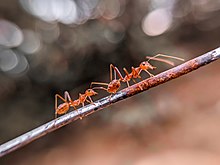Tandem running
[2] As predators, scavengers, and herbivores, ants have a variety of food sources, for which they may journey as far as 200 meters from their nest, spraying a scent trail as they go.
[3] To lead their kin to new food sources, ants demonstrate one of the few examples of interactive teaching outside of the mammalian class.
Social learning by teaching requires that the naive observer change its behavior and acquire some skills or knowledge faster than it would have independently and that the teacher incur some cost.
Ultimately, the knowledge of the route to the new food source can be passed throughout the colony as one follower becomes a leader, making tandem running an effective time-saving practice.
Upon encountering, a pair performs a tandem run, while seeking a suitable site for colony foundation.
[5] Tandem running in termites involves communication via sex pheromones, and all mating pairs engage in this process.
Individual ants utilize celestial and land cues as well as their own motion detection to navigate, but scout foraging is not their only strategy for finding food resources.
During reverse tandem runs, most leaders deploy their gaster in the up or middle position because by this time the ants have learned the route and trails have already been laid, so followers are less likely to get lost.
[7] The time it takes for the leader to reach the food source during a tandem run is increased fourfold.
This may be because trees and other sites are often complex structures to navigate, and the leader may guide the experienced ant to a new food source within the same system.
[11] There is a benefit to being separated from the leader in some cases however; independent exploration is critical to the practice of tandem running.
Through independent exploration, ants can discover new and more direct routes and thus reduce the duration of their subsequent tandem runs that they will lead.
Ants are able to shorten the length of tandem runs and transfer information faster only if they independently explore the area in between being a follower and becoming a leader.
[1] Independent exploration is beneficial because it leads to an improved route and more accurate leadership of tandem runs.


